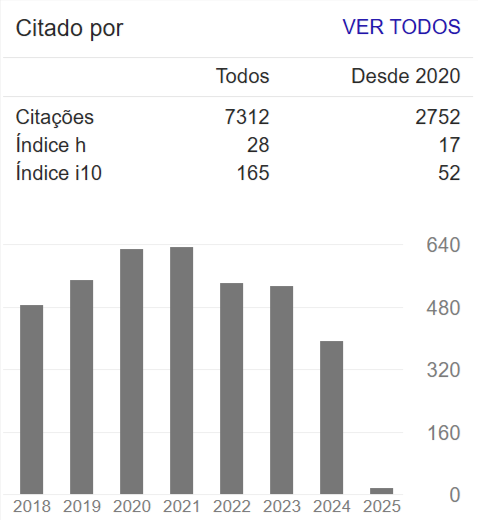Analysis of the water quality of tube wells in the urban area of Itaituba, Pará, Brazil
Abstract
The importance of water in water resources on the planet is one of the most relevant and indispensable elements for the survival of man. With the accelerated growth of urban, industrial and technological society, freshwater scarcity has been compromised. Thus, the population of the cities sought alternatives to acquire this good through the use of tubular wells. For this reason, the need to analyze the quality of these water sources has arisen, which may be the focus of diseases capable of compromising the well-being of its consumers. The aim of this study was to analyze the water quality of tubular wells consumed by the population of the urban area of the municipality of Itaituba, State of Pará, Brazil. 06 (six) tubular wells were selected and 01 (one) sample for physical-chemical analysis and 01 (one) sample for microbiological analysis were collected. Then, a total of 12 (twelve) samples were analyzed in the laboratory of water analysis of VIGIAGUA - Water Surveillance of Itaituba, through the Practical Manual of Water Analysis of FUNASA, evaluating the parameters of chloride, turbidity, total coliforms and thermotolerant coliforms. The results obtained were within normal limits, and: in the physical analysis, the level of turbidity was within acceptable values; in the chemical analysis, there was no chloride; and, in the microbiological analysis, of the 06 (six) samples, the presence of total coliforms was identified in the sample of point 1 and point 2 and, absence of thermotolerant coliforms in all samples. It was concluded that the results of the physicochemical and microbiological analyses of the tubular wells have a quality water and appropriate for the consumption of the Itaitubense population. However, the use of wells as a source of water supply in the absence of sanitary sewage, contributes as a serious problem of public health and basic sanitation in the city. It is suggested the solution and investment in the water treatment and distribution system in the city of Itaituba/PA.
References
BRASIL. Leis, decretos, etc. Portaria nº 2.914 do Ministério da Saúde. Diário Oficial da União, Brasília, 2011.
BRASIL. FUNASA - Fundação Nacional de Saúde. Manual prático de análise de água - 4. ed. – Brasília: Funasa, 2013. 150 p.
CASITA: COMPANHIA DE ÁGUA E SANEAMENTO DE ITAITUBA. Itaituba: ASCOM, 18 jul. 2019. Disponível em: https://www.itaituba.pa.gov.br/noticia/408/casita-companhia-de-agua-e-saneamento-de-itaituba/ Acesso em: 12 abr. 2022.
DANELUZ, Débora; TESSARO, Dinéia. Padrão físico-químico e microbiológico da água de nascentes e poços rasos de propriedades rurais da região sudoeste do Paraná. Arquivos do Instituto Biológico, v. 82, p. 1-5, 2015.
DE MORAES, Cristina. O que é um poço artesiano? Revista Super Interessante, 9 jan. 2017.
DE PAULA E SILVA, F., Hung Kiang, C., & Caetano-Chang, M. R. (2005). Hidroestratigrafia do Grupo Bauru (K) no Estado de São Paulo. Águas Subter-râneas, 19(2). https://doi.org/10.14295/ras.v19i2.8225 Acesso em: 26 jul. 2022.
GOMES-SILVA et al. Qualidade da água de uma microbacia com fins de abastecimento público, Chapada Dos Guimarães, MT. Holos, [s. l.], ano 30, v. 4, p. 22-33, 1 ago. 2014. Disponível em: https://doi.org/10.15628/holos.2014.1977. Acesso em: 8 dez. 2022.
IBGE. Instituto Brasileiro de Geografia e Estatística. Contagem populacional. Disponível em: https://cidades.ibge.gov.br/brasil/pa/itaituba/panorama Acesso em: 02 jun. 2022.
JAWETZ, E.; MELNICK, J.A. & ADELBERG, E.A. Microbiologia Médica. 21. Ed., Rio de Janeiro: Guanabara Koogan, 2000. 175p.
MACHADO, Carlos José Saldanha. Recursos hídricos e cidadania no Brasil: limites, alternativas e desafios. Disponível em: https://www.scielo.br/j/asoc/a/TGsCpQ3L7Zd4FLzSM6WtXHk/?format=pdf&lang=pt Acesso em: 26 jan. 2022.
Orientações para a utilização de Águas Subterrâneas no Estado de São Paulo. In: ABAS – Associação Brasileira de Águas Subterrâneas (Brasil): FIESP - Federação das Indústrias do Estado de São Paulo, Setembro, 2005. Disponível em: https://www.abas.org/arquivos/aguasf.pdf Acesso em: 4 jan. 2023.
SOLDERA, Bruna Camargo. Monitoramento dos níveis freáticos do aqüífero Bauru (Formação Adamantina) no município de Assis-SP. 2011.
SOUZA, Corina Fernandes de et al. Análise da dinâmica: população, ciclos econômicos e sistema de abastecimento de água do município de Itaituba-Pará. 2017.

















